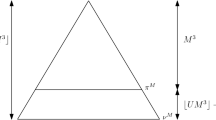We construct a diffusion process in the infinite-dimensional simplex consisting of all nonincreasing infinite sequences of nonnegative numbers with sum less than or equal to one. The process is constructed as a limit of a certain sequence of Markov chains. The state space of the nth chain is the set of all strict partitions of n (that is, partitions with distinct parts). As n →∞, these random walks converge to a continuous-time strong Markov process in the infinite-dimensional simplex. The process has continuous sample paths. The main result about the limit process is an expression for its pre-generator as a formal second-order differential operator in a polynomial algebra. Bibliography: 29 titles.
Similar content being viewed by others
References
A. Berele and B. Tenner, “Doubly symmetric functions” (2009), arXiv:0903.5306v1[math.C0].
A. Borodin, “Multiplicative central measures on the Schur graph,” J. Math. Sci., 96, No. 5, 3472–3477 (1999).
A. Borodin and G. Olshanski, “Infinite-dimensional diffusions as limits of random walks on partitions,” Probab. Theory Related Fields, 144, No. 1, 281–318 (2009), arXiv:0706.1034v2[math.PR].
S. N. Ethier and T. G. Kurtz, Markov Processes: Characterization and Convergence, Wiley-Interscience, New York (1986).
W. J. Ewens, Mathematical Population Genetics, Springer-Verlag, Berlin (1979).
J. Fulman, “Stein method and Plancherel measure of the symmetric group,” Trans. Amer. Math. Soc., 357, 555–570 (2005), arXiv:math/0305423v3[math.RT].
J. Fulman, “Commutation relations and Markov chains,” Probab. Theory Related Fields, 144, No. 1, 99–136 (2009), arXiv:0712.1375v2[math.PR].
A. Gnedin and G. Olshanski, “Coherent permutations with descent statistic and the boundary problem for the graph of zigzag diagrams,” Internat. Math. Res. Notices, Art. ID 51968, 39pp. (2006), arXiv:math/0508131v2 [math.C0].
P. N. Hoffman and J. F. Humphreys, Projective Representations of the Symmetric Groups, Oxford Univ. Press, New York (1992).
V. N. Ivanov, “The dimension of skew shifted young diagrams, and projective characters of the infinite symmetric group,” J. Math. Sci., 96, No. 5, 3517–3530 (1999).
S. Kerov, “Anisotropic Young diagrams and Jack symmetric functions,” Funct. Anal. Appl., 34, No. 1, 41–51 (2000), arXiv:math/9712267v1[math.C0].
S. Kerov, A. Okounkov, and G. Olshanski, “The boundary of the Young graph with Jack edge multiplicities,” Internat. Math. Res. Notices, 4, 173–199 (1998), arXiv:q-alg/9703037v1.
S. Kerov, G. Olshanski, and A. Vershik, “Harmonic analysis on the infinite symmetric group. A deformation of the regular representation,” C. R. Acad. Sci. Paris Sér. I, 316, 773–778 (1993).
S. Kerov, G. Olshanski, and A. Vershik, “Harmonic analysis on the infinite symmetric group,” Invent. Math., 158, No. 3, 551–642 (2004), arXiv:math.RT/0312270.
S. Kerov and A. Vershik, “The Grothendieck group of the infinite symmetric group and symmetric functions with the elements of the K 0-functor theory of AF-algebras,” in: Representations of Lie Groups and Related Topics, Adv. Stud. Contemp. Math., 7, Gordon and Breach, New York (1990), pp. 36–114.
J. F. C. Kingman, “Random partitions in population genetics,” Proc. Roy. Soc. London Ser. A, 361, 1–20 (1978).
I. G. Macdonald, Symmetric Functions and Hall Polynomials, 2nd edition, Oxford Univ. Press, New York (1995).
M. Nazarov, “Projective representations of the infinite symmetric group,” in: A. M. Vershik (ed.), Representation Theory and Dynamical Systems, Adv. Soviet Math., 9, Amer. Math. Soc., Providence, Rhode Island (1992), pp. 115–130.
G. Olshanski, “Anisotropic Young diagrams and infinite-dimensional diffusion processes with the Jack parameter” (2009), arXiv:0902.3395v1[math.PR].
L. Petrov, “Two-parameter family of infinite-dimensional diffusions on the Kingman simplex,” Funct. Anal. Appl., 43, No. 4, 279–296 (2009), arXiv:0708.1930v3[math.PR].
L. Petrov, “Random walks on strict partitions” (2009), arXiv:0904.1823v1[math.PR].
J. Pitman, “The two-parameter generalization of Ewens random partition structure,” Tech. Rep. 345, Dept. Statistics, U. C. Berkeley (1992), http://www.stat.berkeley.edu/teh-reports/.
J. Pitman, Combinatorial Stochastic Processes, École d’Été de Probabilités de Saint-Flour XXXII, 2002, Lect. Notes Math., 1875, Springer-Verlag, Berlin (2006), http://works.bepress.om/jimpitman/1.
I. Schur, “Über die Darstellung der symmetrischen und der alternierenden Gruppe durch gebrocheme lineare Substitionen,” J. Reine Angew. Math., 139, 155–250 (1911).
J. Stembridge, “A characterization of super symmetric polynomials,” J. Algebra, 95, 439–444 (1985).
J. Stembridge, “Shifted tableaux and the projective representations of symmetric groups,” Adv. Math., 74, 87–134 (1989).
J. Stembridge, “On Schur's Q-functions and the primitive idempotents of a commutative Hecke algebra,” J. Algebraic Combin.,1, 71–95 (1992).
E. Thoma, “Die unzerlegbaren, positive-definiten Klassenfunktionen der abzählbar unendlichen, symmetricshen Gruppe,” Math. Z., 85, 40–61 (1964).
H. F. Trotter, “Approximation of semigroups of operators,” Pacific J. Math., 8, 887–919 (1958).
Author information
Authors and Affiliations
Corresponding author
Additional information
Translated from Zapiski Nauchnykh Seminarov POMI, Vol. 373, 2009, pp. 226–272.
Rights and permissions
About this article
Cite this article
Petrov, L. Random walks on strict partitions. J Math Sci 168, 437–463 (2010). https://doi.org/10.1007/s10958-010-9996-8
Received:
Published:
Issue Date:
DOI: https://doi.org/10.1007/s10958-010-9996-8




